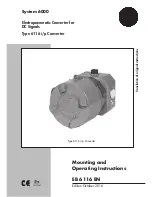
Security Escort
Equipment estimation | en
11
Robert Bosch (SEA) Pte Ltd
Hardware Installation Manual
2018.03 | SE3v1.0 | DOC
3
Equipment estimation
A Security Escort system installation consists of three major steps:
1.
the initial equipment estimate,
2.
the pre-installation coverage verification, and
3.
the post installation after survey.
The SE receivers work effectively in a wide variety of installations and can be placed with
confidence provided these installation requirements are met. Therefore, It is acceptable to
estimate the initial required equipment. To ensure proper coverage after proposal acceptance,
potential SE receiver locations can be verified using a standard SE receiver in test mode or the
portable test SE receiver before installation begins.
3.1
Location accuracy
The Security Escort system provides quick response to a duress call. Its intent is to dispatch a
responding individual to an area without additional delay to their response to that duress call.
The Security Escort system uses radio frequency (RF) for alarm transmissions. This is
significant because it prevents normal construction from blocking the signal and helps to
eliminate dead spots where the alarm could not be heard. The fact that RF energy passes
through normal construction prevents Security Escort from locating an alarm with 100%
certainty to a specific side of a wall. Alarms originating at or near building walls will typically
be indicated within 7.5 m (25 ft) of the actual location. However, there may be times when the
computed location may appear to be on the other side of the wall.
The Security Escort system was designed to provide a computed alarm location typically
within 7.5 m (25 ft) of the actual location when indoors, and a computed alarm location
typically within 15 m (50 ft) of the actual location outdoors. Any deviation from the following
installation guidelines will degrade the computed location accuracy. Therefore, to achieve
accuracy, the following installation guidelines must be adhered to.
3.2
Initial equipment estimate
3.2.1
Number of indoor SE receivers
To estimate the number of indoor SE receivers, read the Indoor SE receiver installation
(Summary) first. Assume the SE receivers are placed on a grid with a maximum spacing of 25
m (80 ft) between SE receivers for standard construction. In multi-floor applications, the SE
receivers on each floor must be placed directly above the SE receivers on the floor below (this
is required for proper floor-to-floor location).
For example, to determine the number of SE receivers required to protect a building of
standard construction of 60 m x 30 m (200 ft x 100 ft) and four floors:
1.
To determine the number of SE receivers in each direction, divide each dimension of the
building by 25 m (80 ft), drop the remainder, and add 1. For example:
–
60 m/25 m = 2.4, becomes 2, add 1 = 3
(200 ft/80 ft = 2.5, becomes 2, add 1 = 3)
–
30 m/25 m =1.2, becomes 1, add 1 = 2
(100 ft/80 ft =1.25, becomes 1, add 1 = 2)
2.
To determine the number of SE receivers required per floor, multiply the number of SE
receivers in one direction by the number of SE receivers in the other direction.
Number of receivers per side x number of sides
- 3 x 2 -= 6
6 SE receivers per floor.
Summary of Contents for SE3000 Series
Page 1: ...Security Escort SE3000 Series en Hardware Installation Manual ...
Page 2: ......
Page 39: ......












































